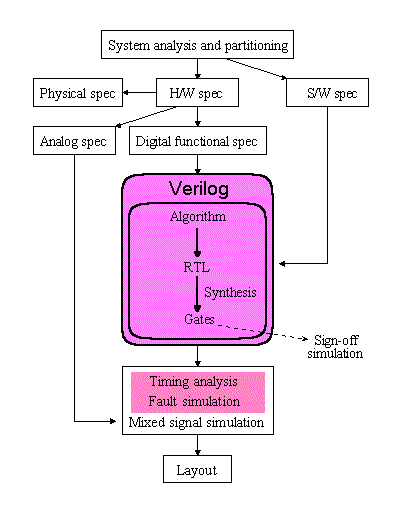Verilog can be used at different levels of abstraction as we have already seen. But how useful are these different levels of abstraction when it comes to using Verilog?
The diagram below shows a very simplified view of the electronic system design process incorporating Verilog. The central portion of the diagram shows the parts of the design process which will be impacted by Verilog.

Verilog is not ideally suited for abstract system-level simulation, prior to the hardware-software split. Unlike VHDL, which has support for user-defined types and overloaded operators which allow the designer to abstract his work into the domain of the problem, Verilog restricts the designer to working with pre-defined system functions and tasks for stochastic simulation and can be used for modelling performance, throughput and queueing but only in so far as those built-in langauge features allow. Designers occasionally use the stochastic level of abstraction for this phase of the design process.
Verilog is suitable for use today in the digital hardware design process, from functional simulation, manual design and logic synthesis down to gate-level simulation. Verilog tools provide an integrated design environment in this area.
Verilog is also suited for specialized implementation-level design verification tools such as fault simulation, switch level simulation and worst case timing simulation. Verilog can be used to simulate gate level fanout loading effects through the import of SDF files.
The RTL level of abstraction is used for functional simulation prior to synthesis. The gate level of abstraction exists post-synthesis but this level of abstraction is not often created by the designer, it is a level of abstraction adopted by the EDA tools (synthesis and timing analysis, for example).
Because of Verilog’s flexibility as a programming language, it has been stretched to handle analog simulation in limited cases. However, look out for future standards in the area of analog Verilog.
![]() Verilog
FAQ
Verilog
FAQ
![]() Doulos Training Courses
Doulos Training Courses
![]() Return to
Hardware Designers Guide Contents
Return to
Hardware Designers Guide Contents
Copyright 1995-1997 Doulos
This page was last updated 10th January 1997.
![]() We welcome your e-mail comments. Please contact us at: webmaster@doulos.co.uk
We welcome your e-mail comments. Please contact us at: webmaster@doulos.co.uk